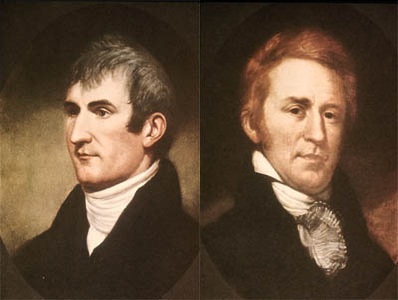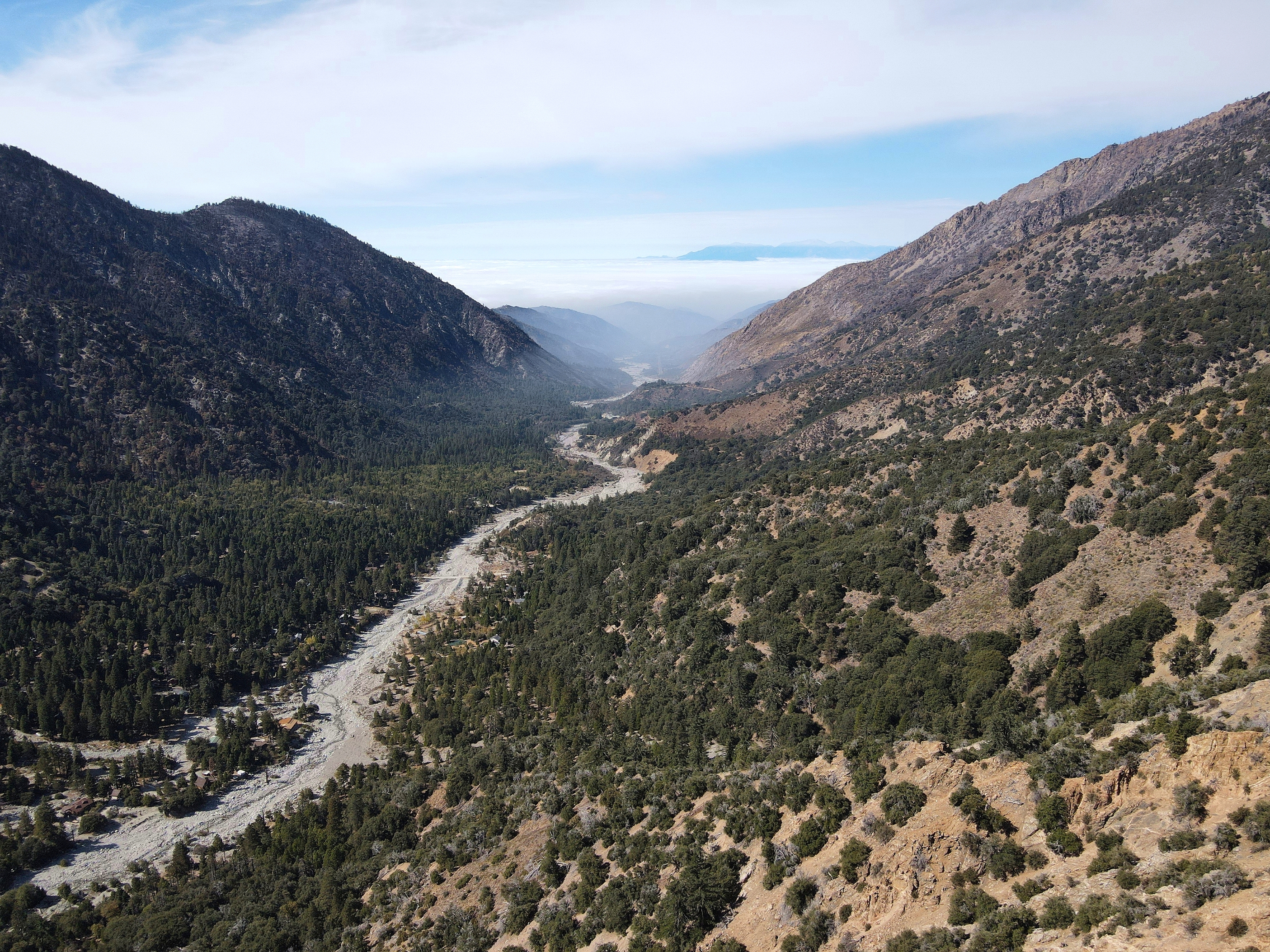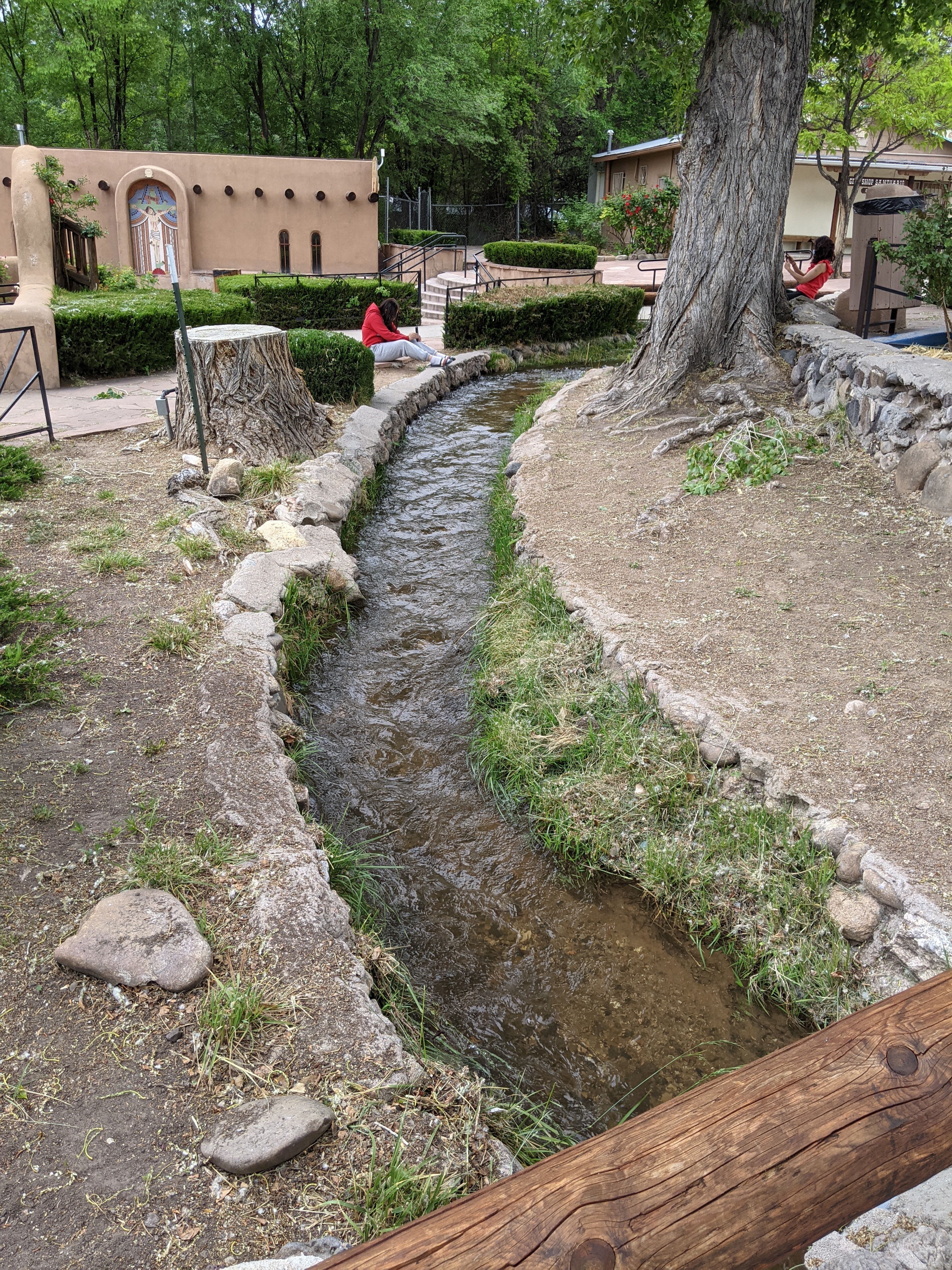|
History Of San Bernardino, California
San Bernardino, California, was named in 1810. Earliest inhabitants San Bernardino's earliest known inhabitants were Serrano Indians (Spanish for "people of the mountains") who spent their winters in the valley, and their summers in the cooler mountains. They were known as the "Yuhaviatam" or People of the Pines. They have lived in the valley since approximately 1000 B.C. They lived in small brush covered structures. At the time the Spanish first visited the valley, approximately 1500 Serranos inhabited the area. They lived in villages of ten to thirty structures that the Spanish named rancherías. The Tongva Indians also called the San Bernardino area Wa'aach in their language. Spanish California Spanish Military Commander of California Pedro Fages probably entered San Bernardino Valley in 1772. Missionary priest Father Francisco Garcés entered the valley in 1774, as did the de Anza Expedition, though not in present-day San Bernardino but further south. The traditi ... [...More Info...] [...Related Items...] OR: [Wikipedia] [Google] [Baidu] |
San Bernardino, California
San Bernardino (; Spanish for "Saint Bernardino") is a city and county seat of San Bernardino County, California, United States. Located in the Inland Empire region of Southern California, the city had a population of 222,101 in the 2020 census, making it the 18th-largest city in California. San Bernardino is the economic, cultural, and political hub of the San Bernardino Valley and the Inland Empire. The governments of El Salvador, Guatemala, and Mexico have established the metropolitan area’s only consulates in the downtown area of the city. Additionally, San Bernardino serves as an anchor city to the 3rd largest metropolitan area in California (after Los Angeles and San Francisco) and the 13th largest metropolitan area in the United States; the San Bernardino-Riverside MSA. Furthermore, the city’s University District serves as a college town, as home to California State University, San Bernardino. San Bernardino was named in 1810, when Spanish priest Francisco Du ... [...More Info...] [...Related Items...] OR: [Wikipedia] [Google] [Baidu] |
San Bernardino De Sena Estancia
The San Bernardino de Sena Estancia (also known as the San Bernardino Rancho or Asistencia) was a ranch outpost of Mission San Gabriel Arcángel in what is now in Redlands, California, United States. It was built to graze cattle, and for Indian reductions of the Serrano people and Cahuilla people into Mission Indians. Over time, it fell into disrepair, until the early 20th century, when a new, larger structure was built as a museum. The new structure shares the same architectural style, but is not otherwise similar to the original buildings. 19th century The ''estancia'' was established in 1819. A second ''estancia'' was established and built around 1830 at Politana rancheria, approximately from the original 1819 site. The Politana site of the San Bernardino de Sena Estancia is a California Historical Landmark. The California missions' lands were secularized in 1833–34. In 1842 Governor Juan B. Alvarado of Alta California issued a Mexican land grant for Rancho San Bernardin ... [...More Info...] [...Related Items...] OR: [Wikipedia] [Google] [Baidu] |
Alta California
Alta California ('Upper California'), also known as ('New California') among other names, was a province of New Spain, formally established in 1804. Along with the Baja California peninsula, it had previously comprised the province of , but was split off into a separate province in 1804 (named ). Following the Mexican War of Independence, it became a territory of Mexico in April 1822 and was renamed in 1824. The territory included all of the modern U.S. states of California, Nevada, and Utah, and parts of Arizona, Wyoming, Colorado, and New Mexico. In the 1836 Siete Leyes government reorganization, the two Californias were once again combined (as a single ). That change was undone in 1846, but rendered moot by the U.S. military occupation of California in the Mexican-American War. Neither Spain nor Mexico ever colonized the area beyond the southern and central coastal areas of present-day California and small areas of present-day Arizona, so they exerted no effective cont ... [...More Info...] [...Related Items...] OR: [Wikipedia] [Google] [Baidu] |
Santa Fe De Nuevo México
Santa Fe de Nuevo México ( en, Holy Faith of New Mexico; shortened as Nuevo México or Nuevo Méjico, and translated as New Mexico in English) was a Kingdom of the Spanish Empire and New Spain, and later a territory of independent Mexico. The first capital was San Juan de los Caballeros (at San Gabriel de Yungue-Ouinge) from 1598 until 1610, and from 1610 onward the capital was La Villa Real de la Santa Fe de San Francisco de Asís. The name of "New Mexico", the capital in Santa Fe, the gubernatorial office at the Palace of the Governors, ''vecino'' citizen-soldiers, and rule of law were retained as the New Mexico Territory and later state of New Mexico became part of the United States. The New Mexican citizenry, primarily consisting of Hispano, Pueblo, Navajo, Apache, and Comanche peoples, became citizens of the United States as a result of the Treaty of Guadalupe Hidalgo (1848). ' is often incorrectly believed to have taken its name from the post-independent nation o ... [...More Info...] [...Related Items...] OR: [Wikipedia] [Google] [Baidu] |
Old Spanish Trail (trade Route)
The Old Spanish Trail ( es, Viejo Sendero Español) is a historical trade route that connected the northern New Mexico settlements of (or near) Santa Fe, New Mexico with those of Los Angeles, California and southern California. Approximately long, the trail ran through areas of high mountains, arid deserts, and deep canyons. It is considered one of the most arduous of all trade routes ever established in the United States. Explored, in part, by Spanish explorers as early as the late 16th century, the trail was extensively used by traders with pack trains from about 1830 until the mid-1850s. The name of the trail comes from the publication of John C. Frémont’s Report of his 1844 journey for the U.S. Topographical Corps, guided by Kit Carson, from California to New Mexico. The name acknowledges the fact that parts of the trail had been known and used by the Spanish since the 16th century. Frémont's report identified a trail that had already been in use for about 15 years. Th ... [...More Info...] [...Related Items...] OR: [Wikipedia] [Google] [Baidu] |
Antonio Armijo
Antonio Mariano Armijo (1804–1850) was a Spanish explorer and merchant who is famous for leading the first commercial caravan party between Abiquiú, Nuevo México and San Gabriel Mission, Alta California in 1829–1830. His route, the southernmost and most direct, is known as the Armijo Route of the Old Spanish Trail. Abiquiú was the starting point and eastern terminus of the original route of the Old Spanish Trail. Though segments of an overland route between the Spanish colonies of Nuevo México and Alta California had been blazed decades earlier, Armijo was the first to pioneer a complete route that traveled the entire length. Armijo traveled with sixty mounted men and a caravan of pack animals carrying blankets and other trade goods to barter for mules in California. The caravan left Abiquiú on 7 November 1829 and made the journey to the San Gabriel Mission in what is now San Gabriel, California San Gabriel (Spanish for " St. Gabriel") is a city located in the Sa ... [...More Info...] [...Related Items...] OR: [Wikipedia] [Google] [Baidu] |
Monument Peak (San Bernardino County)
Old Spanish Trail map Monument Peak is a summit in the San Bernardino Mountains, of San Bernardino County, California. It lies at an elevation of 5272 feet. History Monument Peak is the location where the Mohave Trail crossed the crest of the San Bernardino Mountains after ascending from the headwaters of the Mojave River up Sawpit Canyon and descended down the ridge between Cable Canyon and Devil Canyon to the San Bernardino Valley at the mouth of Cajon Pass. The Garces-Smith Monument is located on the summit on Forest Road 2N49. This marker indicates the path of the Mohave Indian Trail, a centuries-old trade route linking the tribes of the Colorado River to those of the Pacific Ocean. It also memorializes two noted early travelers, Father Francisco Garcés, who in 1776 became the first known missionary explorer to travel across San Bernardino County and leave a written record of his experiences and Jedediah Smith, who in 1826, was the first known Anglo-American to use the M ... [...More Info...] [...Related Items...] OR: [Wikipedia] [Google] [Baidu] |
Mojave Trail
The Mojave Road, also known as Old Government Road (formerly the Mohave Trail), is a historic route and present day dirt road across what is now the Mojave National Preserve in the Mojave Desert in the United States. This rough road stretched from Beale's Crossing (the river crossing site on the west bank of the Colorado River, opposite old Fort Mohave, roughly southwest of Bullhead City, Arizona), to Fork of the Road location along the north bank of the Mojave River where the old Mojave Road split off from the route of the Old Spanish Trail/Mormon Road. A four-wheel drive vehicle is required for all but a few short stretches of this road, which is unmaintained. The old road from Fork of the Road eastward along the Mojave River is interrupted after by private property, below the site of the old Camp Cady (on the north bank of the Mojave River, roughly northeast of Newberry Springs, California). The road is resumed at an access point from the north in Manix Wash. Under opt ... [...More Info...] [...Related Items...] OR: [Wikipedia] [Google] [Baidu] |
San Bernardino Mountains
The San Bernardino Mountains are a high and rugged mountain range in Southern California in the United States. Situated north and northeast of San Bernardino and spanning two California counties, the range tops out at at San Gorgonio Mountain – the tallest peak in all of Southern California. The San Bernardinos form a significant region of wilderness and are popular for hiking and skiing. The mountains were formed about eleven million years ago by tectonic activity along the San Andreas Fault, and are still actively rising. Many local rivers originate in the range, which receives significantly more precipitation than the surrounding desert. The range's unique and varying environment allows it to maintain some of the greatest biodiversity in the state. For over 10,000 years, the San Bernardinos and their surroundings have been inhabited by indigenous peoples, who used the mountains as a summer hunting ground. Spanish explorers first encountered the San Bernardinos in the late ... [...More Info...] [...Related Items...] OR: [Wikipedia] [Google] [Baidu] |
Jedediah Strong Smith
Jedediah Strong Smith (January 6, 1799 – May 27, 1831) was an American clerk, transcontinental pioneer, frontiersman, hunter, trapper, author, cartographer, mountain man and explorer of the Rocky Mountains, the Western United States, and the Southwest during the early 19th century. After 75 years of obscurity following his death, Smith was rediscovered as the American whose explorations led to the use of the -wide South Pass as the dominant point of crossing the Continental Divide for pioneers on the Oregon Trail. Coming from modest family background, Smith traveled to St. Louis and joined William H. Ashley and Andrew Henry's fur trading company in 1822. Smith led the first documented exploration from the Salt Lake frontier to the Colorado River. From there, Smith's party became the first United States citizens to cross the Mojave Desert into what is now the state of California but which at that time was part of Mexico. On the return journey, Smith and his compani ... [...More Info...] [...Related Items...] OR: [Wikipedia] [Google] [Baidu] |
Mill Creek (San Bernardino County)
Mill Creek is a U.S. Geological Survey. National Hydrography Dataset high-resolution flowline dataThe National Map, accessed March 16, 2011 stream, originating in the San Bernardino Mountains, in San Bernardino County, California. It is a major tributary of the Santa Ana River. Their confluence occurs just downstream of the upper Santa Ana Canyon mouth. Part of the upper creek flows through San Bernardino National Forest, with the headwaters (High Creek and Mill Creek Jumpoff), being in the San Gorgonio Wilderness. Mill Creek is in much better condition than the lower portions of the Santa Ana watershed, as its drainage area is less urbanized. However, the creek has three hydroelectric plants owned by Southern California Edison. The first commercial power plant in the United States using three-phase alternating current was the 250 kilowatt Mill Creek No. 1 Hydroelectric Plant, near Redlands, California, in 1893 designed by Almarian Decker. The streambed is completely dewatered ... [...More Info...] [...Related Items...] OR: [Wikipedia] [Google] [Baidu] |
Irrigation Ditch
An acequia () or séquia () is a community-operated watercourse used in Spain and former Spanish colonies in the Americas for irrigation. Particularly in Spain, the Andes, northern Mexico, and the modern-day American Southwest particularly northern New Mexico and southern Colorado, acequias are usually historically engineered canals that carry snow runoff or river water to distant fields. Examples of acequias in New Mexico have lengthy historical roots to Pueblo and Hispano communities, and they are incorporated into traditions including the matachines, life in the Rio Grande Bosque of the Albuquerque metropolitan area, and pilgrimages to El Santuario de Chimayo. The term can also refer to the long central pool in a Moorish garden, such as the Generalife in the Alhambra in Southern Iberia. Overview The Spanish word (and Catalan ) comes from Classical Arabic , which has the double meaning of 'the water conduit' or 'one that bears water' and the 'barmaid' (from , 'to g ... [...More Info...] [...Related Items...] OR: [Wikipedia] [Google] [Baidu] |


.jpg)





